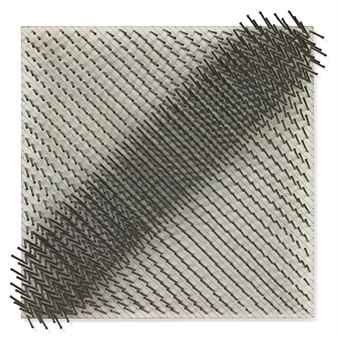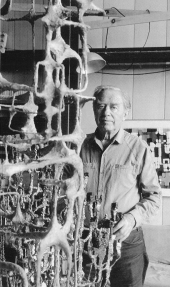
Günther Uecker (b. 1930)
Diagonale Struktur
signed, inscribed, titled and dated 'Diagonale Struktur Uecker 75 Serie 1-10 No. 8 parallelstrukturen 1965-1975' (on the reverse)
nails and graphite on linen laid down on wood
15 3/8 x 15 3/8 x 3 1/8in. (40 x 40 x 8.5cm.)
Diagonale Struktur
signed, inscribed, titled and dated 'Diagonale Struktur Uecker 75 Serie 1-10 No. 8 parallelstrukturen 1965-1975' (on the reverse)
nails and graphite on linen laid down on wood
15 3/8 x 15 3/8 x 3 1/8in. (40 x 40 x 8.5cm.)
Executed in 1975
Nails on painted wood.
200 × 150 x 16 cm (78 3/5 x 59 x 6 2/5 in).
Signed, titled and dated ‘Günther Uecker Mutation 2006’ on the reverse. This work is accompanied by a certificate of authenticity.
200 × 150 x 16 cm (78 3/5 x 59 x 6 2/5 in).
Signed, titled and dated ‘Günther Uecker Mutation 2006’ on the reverse. This work is accompanied by a certificate of authenticity.
German sculptor and stage designer. He studied painting at the Kunstakademie in Berlin-Weissensse (1949–53), working first in the style of Socialist Realism. During his period at the Kunstakademie in Düsseldorf he undertook self-imposed repetitive exercises such as archery, and he modelled his first relief-form paintings by hand. In 1957 he made his first relief structures with nails leading to works such as White Picture (nails on canvas on wood, 1959; Krefeld, Kaiser-Wilhelm Mus.). He also incorporated corks (e.g. Cork Picture Light Medium, 1960; Düsseldorf, Kstmus.) and cardboard tubes set into the surface of the painting. The nailed picture became the antithesis of the painted picture; it allowed Uecker to explore the articulation of light through the shadows created by the nails, the unchanging ritual of hammering and the violation of taboo surfaces. In 1958 he began to work on circular nail formations, leading in 1961 to his rotating nailed illuminated discs.
Within the Zero group, which he joined in 1961 after participating in the exhibition Das rote Bild in Otto Piene’s studio (1958), Uecker developed fantastic projects to jolt and stimulate the imagination of an ossified society, such as painting a street white as part of the Zero demonstration in 1961 (see Honisch and Haedecke, p. 69). From 1963 he nailed items of furniture such as chairs, pianos and television sets, for example TV on Table (artist’s col., see Honisch and Haedecke, p. 194). Rotation continued, for example in the nailed fabric sculptures that inflate through centrifugal force, or in the Sand Mills. After 1967, influenced by Land art, Body art and cConceptual art, Uecker’s work slowly moved towards a critical analysis of prevalent structures, exemplified by Chichicastenango (1980; Krefeld, Pax Christi Church), a nailed-up boat symbolic of the martyrdom of South American Indians by the Catholic missions. The Black Mesa cycle of 1984 (artist’s col.; Kiel, Christian Alberts-U., Ksthalle), exhibited in Mönchengladbach at the Städtisches Museum Abteiburg, takes as its theme the threatening of a table mountain in South Dakota holy to the Indians. From 1974 Uecker made several stage sets for opera productions including Fidelio (Bremen), Parsifal (1976; Stuttgart) andLohengrin (1979; Bayreuth Festival).





